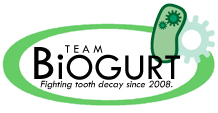From 2008.igem.org
|
|
|
Welcome to the MIT team Wiki for iGEM 2008
- iGEM is the international genetically engineered machines competition.
- The objective of the competition is to design and build an engineered biological system using [http://en.wikipedia.org/wiki/DNA DNA].
- To see examples of the amazing possibilities of iGEM, check out last years [http://parts.mit.edu/igem07/index.php/Main_Page iGEM page]
- Read our promotional brochure to learn about synthetic biology at MIT (front and back).
- iGEM at MIT is possible because of outside support, contact Tom Knight (tk [at] mit.edu) to help out!
|
 Resources
Resources
Interested in learning more about iGEM 2008? Explore below for an example of what's possible.
For more info on this year's iGEM please see 2008.igem.org.
Many more valuable links and helpful tidbits are available at the [http://parts.mit.edu/wiki/index.php/Resources iGEM Resources page]
For visitors
- Read more about engineering biology.
- [http://stellar.mit.edu/S/course/20/sp08/20.020/ 20.020: MIT's introduction to bioengineering design]
External links
- iGEM on OpenWetWare
- [http://parts.mit.edu/registry BioBricks Parts registry]
- [http://parts.mit.edu/igem07/index.php/Main_Page Official iGEM 2007 wiki]
- [http://parts.mit.edu/igem Official iGEM 2006 wiki]
- [http://openwetware.org/wiki/IGEM:MIT/2007 MIT 2007 Wiki]
- [http://parts.mit.edu/wiki/index.php/MIT_2006 MIT 2006 Wiki]
- BioBricks parts contributed by MIT:
- [http://parts.mit.edu/registry/index.php/Part:BBa_I728005 OmpC Surface Display]
- [http://parts.mit.edu/registry/index.php/Part:BBa_I728004 CPX Surface Display]
- [http://openwetware.org/wiki/20.109(S08) 20.109 instructions (2008)]
Internal links
- [[../2008/Notebook/Yogurt|Team Notebook]]
Protocols
- [http://openwetware.org/wiki/Endy:DNA_ligation_using_T4_DNA_ligase T4 ligation]
- [http://openwetware.org/wiki/TOP10_chemically_competent_cells Top10 chem competent cell transformation]
- [http://web.mit.edu/biopolymers/www/DNA.html DNA sequencing]
- [http://openwetware.org/wiki/Endy_pcr PCR]
- [http://openwetware.org/wiki/Knight:Restriction_Digest Restriction Digests]
Good Lab Citizenship
Wiki editing resources
- Simple wiki editing examples
- [http://en.wikipedia.org/wiki/Wikipedia:How_to_edit_a_page How to edit a page (extended - wikipedia)]
- [http://www.mediawiki.org/wiki/Help:Images Help with images (wikipedia)]
- [http://en.wikipedia.org/wiki/Help:Table Help with tables (wikipedia)]
|
 Information
Information
Want to help out the iGEM team?
- iGEM at MIT is partly supported by the [http://web.mit.edu/urop/basicinfo/ Undergraduate Research Opportunity Program] and faculty including Drew Endy and Tom Knight.
- We guarantee UROP funding for undergrads. We need help to continue supporting undergrads, paying registration fees, and supplying lab reagents, contact Tom Knight to help out!
- Read more about our team on our fundraising notebook.
Schedule
- April 10 - UROP funding deadline
- April 18 - iGEM registration opens
- May 3 - Teachers Workshop, MIT, USA
- May 9 - Registration closes
- June 9 - Summer term, lab work begins
- June 15 - Team rosters due
- July 1 - Registration fee due
- August 1 - Team project descriptions due
- August 19 - Summer term ends
- September 1 - Final team roster due
- October 1 - Jamboree attendance fees due
- October 15 - Project Summary form due
- October 29 - Project and part documentation due
- October 29 - BioBrick Part DNA received by the Registry
- November 8-9 - iGEM competition Jamboree, MIT, USA
Brainstorming
Meeting Logistics
|
 People
People
The MIT iGEM team consists of six undergraduate students working full-time during summer 2008 on engineering a biological system. In addition, we have a number of graduate student and faculty advisers.
Picture of MIT iGEM 2008 (coming soon!)
Students
Grad Advisors
Faculty Advisors
Email grads: grads [AT] igem.mit.edu
Email undergrads: team [AT] igem.mit.edu
alternative address: igem2008-all [AT] mit.edu
|
|
|
* Our goal is to engineer a common yogurt bacteria, Lactobacillus bulgaricus, so that it will express the 20aa peptide p1025. A clinical study (Kelly CG et al.; Nature Biotechnol. 1999) reports that p1025 is good for your teeth. p1025 reduces oral colonization of Streptococcus mutans, a tooth-decaying bacterium.
*
o Stage 1: Construction of p1025 fusion peptide and expression of gene in E. coli. This is an intermediate step to evaluate gene function and protein secretion/efficacy.
o Stage 2: Binding Assay - see if the p1025 produced by E.coli inhibits binding of S. mutants to hydroxyapatite (HA) beads.
o Stage 3: Expression of p1025 in Lactobacillus.
o Stage 4: Make yogurt with modified Lactobacillus and test for inhibition of S. mutants binding.
|
|
|
(Or you can choose different headings. But you must have a team page, a project page, and a notebook page.)
 "
"
